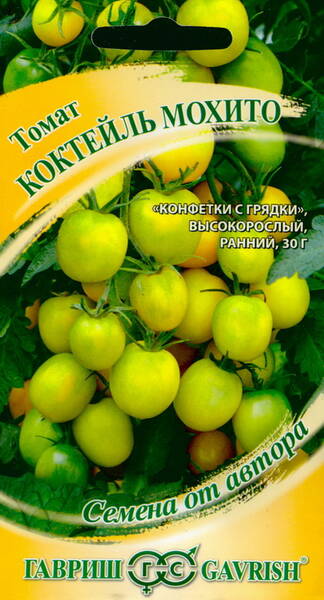Your shopping cart is empty!
Tomato "Cocktail Mojito"
Tomato "Cocktail Mojito".
A very sweet and aromatic variety of cocktail tomato with fruity and citrus notes in taste, with heavy clusters of emerald fruits weighing up to 30 g.
Well suited for canning and pickling, but its main purpose is salad. The plant is tall and recommended for growing in greenhouses. Ripens early, on average 110 days from sowing the seeds. The productivity is very high, due to the large number of branched racemes with many fruits.
The clusters are removed either completely or by collecting individual fruits as they ripen, since usually a small part of the tomatoes at the ends of the clusters may ripen later.
Sowing of seedlings is carried out in early March. Planting seedlings in greenhouses - in May. A few days after planting, the plants are formed into one stem, removing all the “stepchildren” and tied to supports. Planting pattern: 40x60 cm.
It is recommended to treat plants with fungicides and feed them with mineral fertilizers as necessary.
Seeds remain viable for 10 years under optimal storage conditions. It is recommended to increase the seeding rate after the expiration date.
A very sweet and aromatic variety of cocktail tomato with fruity and citrus notes in taste, with heavy clusters of emerald fruits weighing up to 30 g.
Well suited for canning and pickling, but its main purpose is salad. The plant is tall and recommended for growing in greenhouses. Ripens early, on average 110 days from sowing the seeds. The productivity is very high, due to the large number of branched racemes with many fruits.
The clusters are removed either completely or by collecting individual fruits as they ripen, since usually a small part of the tomatoes at the ends of the clusters may ripen later.
Sowing of seedlings is carried out in early March. Planting seedlings in greenhouses - in May. A few days after planting, the plants are formed into one stem, removing all the “stepchildren” and tied to supports. Planting pattern: 40x60 cm.
It is recommended to treat plants with fungicides and feed them with mineral fertilizers as necessary.
Seeds remain viable for 10 years under optimal storage conditions. It is recommended to increase the seeding rate after the expiration date.











